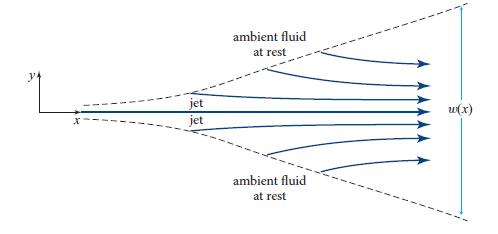Consider a narrow, 2-dimensional, incompressible (i.e., subsonic) jet emerging from a 2-dimensional nozzle into ambient fluid at
Question:
Consider a narrow, 2-dimensional, incompressible (i.e., subsonic) jet emerging from a 2-dimensional nozzle into ambient fluid at rest with the same composition and pressure. (By 2-dimensionalwemean that the nozzle and jet are translation symmetric in the third dimension.) Let the Reynolds number be low enough for the flow to be laminar; we study the turbulent regime in Ex. 15.7.We want to understand how rapidly this laminar jet spreads.
(a) Show that the pressure forces far downstream from the nozzle are likely to be much smaller than the viscous forces and can therefore be ignored.
(b) Let the jet’s thrust per unit length (i.e., the momentum per unit time per unit length flowing through the nozzle) be F. Introduce Cartesian coordinates x, y, with x parallel to and y perpendicular to the jet (cf. Fig. 15.4). As in Ex. 15.1, use vorticity diffusion (or the Navier-Stokes equation) and momentum conservation to estimate the speed vx of the jet and its width w as functions of distance x downstream.
(c) Use the scalings from part (b) to modify the self-similarity analysis of the Navier-Stokes equation that we used for the laminar boundary layer in Sec. 14.4, and thereby obtain the following approximate solution for the jet’s velocity profile:

(d) Equation (15.9) shows that the jet width w increases downstream as x2/3. As the jet widens, it scoops up (entrains) ambient fluid, as depicted in Fig. 15.4. This entrainment actually involves pulling fluid inward in a manner described by the y component of velocity, vy. Solve the incompressibility equation ∇ · v = 0 to obtain the following expression for vy:

Thus ambient fluid is pulled inward from both sides to satisfy the jet’s entrainment appetite.
Figure 15.4.

Data from Exercises 15.1.
We explore the structure of the wake behind the cylinder when the Reynolds number is high enough that the flow is turbulent. For comparison, here we compute the wake’s structure at lower Reynolds numbers, when the wake is laminar.
This computation is instructive: using order-of-magnitude estimates first, followed by detailed calculations, it illustrates the power of momentum conservation. It is our first encounter with the velocity field in a wake.
Equation. 15.5.

Data from Exercises 15.7
Consider a 2-dimensional turbulent jet emerging into an ambient fluid at rest, and contrast it to the laminar jet analyzed in Ex. 15.3.
Step by Step Answer:

Modern Classical Physics Optics Fluids Plasmas Elasticity Relativity And Statistical Physics
ISBN: 9780691159027
1st Edition
Authors: Kip S. Thorne, Roger D. Blandford





